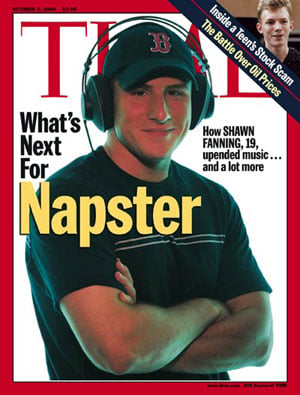The history of Napster dates back to 1999. It was developed by Shawn Fanning and Sean Parker as a P2P file distribution system, although it was not fully peer-to-peer. It used central servers to maintain lists of connected systems and the files they provided, while actual transactions were conducted directly between client machines.
Quick Facts
- Creator (person)
- Shawn Fanning, Sean Parker
- Original Price
- free
- Operating System
- Windows, iOS, Mac OS, etc.
- Developed By (company)
- MelodyVR
The release of Napster completely revolutionized how we listen to music. The software allowed users to share and download music encoded in Mp3 format for free. Napster gained massive popularity because of its user-friendly interface and easy access to music files for millions of internet users.
6 Facts about Napster
- Napster gained millions of users shortly after its launch. At its peak, it had 80 million registered users, mostly students on college campuses. It was so popular that some schools burned it to avoid network congestion.
- The developer of Napster, Shawn Fanning, conceived the idea at the age of 18 while in college after hearing his roommate complain of the difficulties of downloading music online. He later dropped out to focus on developing a cataloging system that could search hard drives, list the MP3s in it, and allow anyone using the software to listen and share.
- On October 2, 2000, Time magazine declared Napster among the top-ranking internet applications alongside email and instant messaging. At the same time, Time magazine featured Shawn Fanning in its cover story and heralded him as a pioneer in computing.
- Napster favored music lovers than it did music sellers. The years following its release saw a massive drop in CD sales. Between 1999 and 2009, CD sales and licensing dropped by $8.3 billion. As Fanning explained to the BBC World Service, “Napster was something that provided a better, more reliable and fun way for people to share music and see each other’s music collection. For the first time, this full history of recorded music was available online to everyone instantly.”
- While Napster was growing and becoming popular, it was entangled in lawsuits and prolonged court battles over the distribution of copyrighted materials. This resulted in its shutdown in 2001. The legal fees and damages completely paralyzed its operations, and by 2002, it could not pay its staff leading to layoffs and resignations.
- Although it didn’t last long, Napster left a mark. It changed the way we purchase, listen and share music. As a result, the record label industry diversified into digital marketplaces, subscriptions of music services, and introduced a way of buying a single song rather than the whole album.

What is Napster: Explained
Napster is an audio streaming service owned by MelodyVR which allows users to share music over the Internet. On June 1, 1999, its creators, Shawn Fanning and Sean Parker, first launched Napster. Fanning intended to create a system that would make music sharing instant and free—and that, he successfully did.
Napster quickly attracted users, and by the summer of 2000, 20 million users were onboard, and about 14000 songs were downloaded every minute. The same year, Fanning and Napster were featured on the covers of two of the most popular magazines—Newsweek and Time (see the image below).

At its peak, the estimated number of registered users was 80 million and massive popularity in colleges to the extent that some schools had to ban it from easing network congestion.
Napster’s success was, however, short-lived because it was caught up in a string of lawsuits over copyright infringement which drained its coffers. First, the Recording Industry Association of America (RIIA) almost immediately (in December 1999) filed a suit against it, then the rock band Metallica in April 2000.
An injunction was issued in March 2001 ordering Napster to prevent the trading of copyrighted music on its network. In July 2001, Napster shut down its entire network to comply with the injunction. In September 2001, the case was partially settled, as Napster agreed to pay music creators and copyright owners a $26 million settlement for past, unauthorized uses of music, as well as an advance against future licensing royalties of $10 million. Napster attempted to convert their free service to a subscription system to pay those fees. Thus, traffic to Napster was reduced.
Although the original service was shut down, it paved the way for decentralized peer-to-peer file-distribution programs, which have been much harder to control.
How to Use Napster
Unlike the music streaming services we have today, such as Spotify and iTunes, which you can access with a click of a mouse, Napster has a relatively different way of distributing MP3 files. The songs live in users’ machines rather than a centralized computer system. This means you download songs from other people’s machines, the distance notwithstanding. Here is how the original Napster worked: First, you needed to download the software and mark the directory containing your music files as “shared” to make it accessible to other Napster users.
Then you would connect to the Internet, fire up the Napster software then type the name of the song or artist you are looking for. Napster would then log you to the central server whose purpose was to keep all the online users’ indexes. Whenever a match of your requested song was found, Napster would inform you to establish a connection with the system hosting the file to download it for free.
The Difference Between Napster and Spotify
While both are music streaming services, they differ in many ways. Napster started as a cataloging system that stored MP3s in the hard drives of registered users and allowed them to share and download songs for free. On the other hand, Spotify is a music streaming service that allows easy and instant access to music and podcasts.
As an online music store, Napster’s music library has around 60 million songs. Spotify prides itself in a vast music catalog of over 70 million songs, including podcasts.
In terms of music discovery, Spotify has the best algorithms which allow independent artists to reach a wider audience within a considerable budget. Napster does not have as many extensive selection algorithms and would not be ideal if you are looking for a refined mixtape of fresh music.
Napster provides the highest streaming quality of 320kb/s on mobile apps, but on PC, users can only download songs at 192kb/s. On the other hand, Spotify allows users to switch from low to very high streaming speed, which is 320kb/s and a download quality consistent with the current bitrate.
Napster: Release History
Napster was a brainchild of a 19-year-old US computer hacker—Shawn Fanning, whose aim was to develop a system that would make sharing and downloading music easy and free. He imagined a solution to help users access music files without relying on a centralized server system. His drive to revolutionize the record industry pushed him to drop out of college to concentrate on developing the code for his system.
Shawn Fanning later met his cofounder Sean Parker in a chatroom, and the two collaborated to push the Napster idea. Fanning fine-tuned the code while Parker worked on securing money from investors. On June 1, 1999, Napster was officially launched as a peer-to-peer file-sharing network. Although similar networks facilitated the distribution of files across the Internet, such as IRC, Hotline, and USENET, Napster specialized exclusively in music in the form of MP3 files and presented a user-friendly interface. This made it acquire users within a short time and become more popular.
However, Napster didn’t last long. Not so long after its launch, various organizations sued Napster over copyright infringement. Napster’s facilitation of the transfer of copyrighted material (songs) raised the ire of the Recording Industry Association of America (RIAA), which almost immediately (in December 1999), filed a lawsuit against it. In April 2000, the rock band Metallica also sued Napster for copyright infringement.
An injunction was issued in March 2001 ordering Napster to prevent the trading of copyrighted music on its network. In July 2001, Napster shut down its entire network in order to comply with the injunction. In Sep 2001, the case was partially settled, as Napster agreed to pay music creators and copyright owners a $26 million settlement for past, unauthorized uses of music, as well as an advance against future licensing royalties of $10 million. In order to pay those fees, Napster attempted to convert their free service to a subscription system. Thus traffic to Napster was reduced. Although the original software was shut down, it paved the way for modern decentralized peer-to-peer file-distribution programs.
Today, users can still access Napster services through their official website.
Up Next…
Interested in finding out more about awesome technological strides that changed the course of history? Read about them in these articles here.
- Facebook: Complete Guide — History, Products, Founding, and More: The mere process of creating it very nearly landed Mark Zuckerberg in hot water. Find out the story of one of the most successful forms of social media of all time.
- The History of Redbox: It reached its height in 2013, and turned its hand to streaming in 2017, however, faced with plummeting sales it has been forced to make even more changes. What does the future hold for this stalwart?
- BitTorrent: Complete Guide — History, Products, Founding, and More: It was designed over 20 years ago in the aim of enabling efficient file downloads. Find out how it was created and how it works.
The image featured at the top of this post is ©Joi Ito / CC BY 2.0, Flickr.







